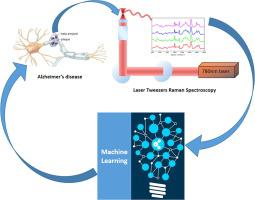Spectrochimica Acta Part A: Molecular and Biomolecular Spectroscopy ( IF 4.4 ) Pub Date : 2022-06-22 , DOI: 10.1016/j.saa.2022.121542 Manman Lin 1 , Haisheng Ou 2 , Peng Zhang 3 , Yanhong Meng 3 , Shenghao Wang 3 , Jing Chang 3 , Aiguo Shen 4 , Jiming Hu 4

|
Alzheimer’s disease (AD) is a common nervous system disease to affect mostly elderly people over the age of 65 years. However, the diagnosis of AD is mainly depend on the imaging examination, clinical assessments and neuropsychological tests, which may get error diagnosis results and are not able to detect early AD. Here, a rapid, non-invasive, and high accuracy diagnostic method for AD especially early AD is provided based on the laser tweezers Raman spectroscopy (LTRS) combined with machine learning algorithms. AD platelets from different 3xTg-AD transgenic rats at different stages of disease are captured to collect high signal-to-noise ratio Raman signals without contact by LTRS, which is then combined with partial least squares discriminant analysis (PLS-DA), support vector machine (SVM) and principal component analysis (PCA)-canonical discriminate function (CDA) for classification. The results show that the normal and diseased platelets at 3-, 6- and 12-month AD are successfully distinguished and the accuracy is 91%, 68% and 97% respectively, which demonstrates the suggested method can provide a precise detection for AD diagnosis at early, middle and advanced stages.
中文翻译:

激光镊子拉曼光谱结合机器学习诊断阿尔茨海默病
阿尔茨海默病 (AD) 是一种常见的神经系统疾病,主要影响 65 岁以上的老年人。然而,AD的诊断主要依靠影像学检查、临床评估和神经心理学测试,可能会得到错误的诊断结果,不能早期发现AD。在这里,基于激光镊子拉曼光谱(LTRS)结合机器学习算法,为AD特别是早期AD提供了一种快速、无创、高精度的诊断方法。捕获来自不同疾病不同阶段的3xTg-AD转基因大鼠的AD血小板,通过LTRS在不接触的情况下收集高信噪比拉曼信号,然后结合偏最小二乘判别分析(PLS-DA),支持向量机 (SVM) 和主成分分析 (PCA) - 规范判别函数 (CDA) 进行分类。结果表明,AD 3 个月、6 个月和 12 个月的正常血小板和病变血小板成功区分,准确率分别为 91%、68% 和 97%,表明该方法可为 AD 诊断提供精确检测。在早期、中期和晚期阶段。



























 京公网安备 11010802027423号
京公网安备 11010802027423号